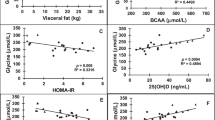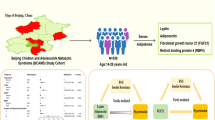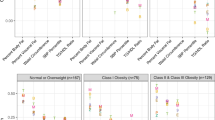Abstract
Objective:
Resistin has been linked with obesity and hypothesized as a potential marker of insulin resistance in addition to being linked with acute inflammation. However, these links are still highly controversial in humans. Our goal was to examine resistin levels in relation to obesity, insulin resistance and inflammation markers in a large population of Asian children and adolescents.
Methods:
Children and adolescents (n=3472) aged 6–18 years, boys (n=1765) and girls (n=1707), were assessed for body size parameters, pubertal development, blood lipids, glucose, insulin, resistin, C-reactive protein (CRP), adiponectin and complement C3 (C3) levels.
Results:
Resistin increased with central obesity in both genders but not with simple adiposity in boys. Several markers associated with central obesity correlated in a gender-specific fashion with plasma resistin. Waist circumference, fat-mass percentage, waist-to-height ratio and body mass index (BMI) positively correlated with resistin in both genders. Blood lipids such as triglycerides, nonesterified fatty acids (NEFA) and low-density lipoprotein cholesterol, diastolic and systolic blood pressure correlated positively with resistin in boys. NEFA, high-density lipoprotein cholesterol (negatively) and inflammation markers, such as CRP and C3, positively correlated with resistin in girls. There was no correlation between resistin and adiponectin, and no association of adiponectin with resistin quintiles in either boys or girls. In both boys and girls, resistin tended to decrease with age, with girls having higher levels than boys. Few indices of insulin resistance were linked with plasma resistin in either gender.
Conclusion:
In this population, plasma resistin levels are a weak biochemical marker of metabolic dysfunction defined by central obesity, adiposity and inflammation and does not predict insulin resistance. Only a small proportion of resistin variation can be explained by factors related to metabolic syndrome, suggesting that resistin is not strongly implicated in a concentration-dependent fashion in any of the examined pathologies.
This is a preview of subscription content, access via your institution
Access options
Subscribe to this journal
Receive 12 print issues and online access
$259.00 per year
only $21.58 per issue
Buy this article
- Purchase on Springer Link
- Instant access to full article PDF
Prices may be subject to local taxes which are calculated during checkout




Similar content being viewed by others
References
Steppan CM, Bailey ST, Bhat S, Brown EJ, Banerjee RR, Wright CM et al. The hormone resistin links obesity to diabetes. Nature 2001; 6818: 307–312.
Steppan CM, Lazar MA . Resistin and obesity-associated insulin resistance. Trends Endocrinol Metab 2002; 1: 18–23.
Patel L, Buckels AC, Kinghorn IJ, Murdock PR, Holbrook JD, Plumpton C et al. Resistin is expressed in human macrophages and directly regulated by PPAR gamma activators. Biochem Biophys Res Commun 2003; 2: 472–476.
Kim KH, Lee K, Moon YS, Sul HS . A cysteine-rich adipose tissue-specific secretory factor inhibits adipocyte differentiation. J Biol Chem 2001; 14: 11252–11256.
Fain JN, Cheema PS, Bahouth SW, Hiler ML . Resistin release by human adipose tissue explants in primary culture. Biochem Biophys Res Commun 2003; 3: 674–678.
Yura S, Sagawa N, Itoh H, Kakui K, Nuamah MA, Korita D et al. Resistin is expressed in the human placenta. J Clin Endocrinol Metab 2003; 3: 1394–1397.
Minn AH, Patterson NB, Pack S, Hoffmann SC, Gavrilova O, Vinson C et al. Resistin is expressed in pancreatic islets. Biochem Biophys Res Commun 2003; 2: 641–645.
Kawashima J, Tsuruzoe K, Motoshima H, Shirakami A, Sakai K, Hirashima Y et al. Insulin down-regulates resistin mRNA through the synthesis of protein(s) that could accelerate the degradation of resistin mRNA in 3T3-L1 adipocytes. Diabetologia 2003; 2: 231–240.
Shojima N, Sakoda H, Ogihara T, Fujishiro M, Katagiri H, Anai M et al. Humoral regulation of resistin expression in 3T3-L1 and mouse adipose cells. Diabetes 2002; 6: 1737–1744.
Delhanty PJD, Mesotten D, McDougall F, Baxter RC . Growth hormone rapidly induces resistin gene expression in white adipose tissue of spontaneous dwarf (SDR) rats. Endocrinology 2002; 6: 2445–2448.
Wolfing B, Neumeier M, Buechler C, Aslanidis C, Scholmerich J, Schaffler A . Interfering effects of insulin, growth hormone and glucose on adipokine secretion. Exp Clin Endocrinol Diabetes 2008; 1: 47–52.
Moon B, Kwan JJM, Duddy N, Sweeney G, Begum N . Resistin inhibits glucose uptake in L6 cells independently of changes in insulin signaling and GLUT4 translocation. Am J Physiol Endocrinol Metab 2003; 1: E106–E115.
Palanivel R, Maida A, Liu Y, Sweeney G . Regulation of insulin signalling, glucose uptake and metabolism in rat skeletal muscle cells upon prolonged exposure to resistin. Diabetologia 2006; 1: 183–190.
Palanivel R, Sweeney G . Regulation of fatty acid uptake and metabolism in L6 skeletal muscle cells by resistin. FEBS Lett 2005; 22: 5049–5054.
Sheng CH, Di J, Jin Y, Zhang YC, Wu M, Sun Y et al. Resistin is expressed in human hepatocytes and induces insulin resistance. Endocrine 2008; 33: 135–143.
Rajala MW, Lin Y, Ranalletta M, Yang XM, Qian H, Gingerich R et al. Cell type-specific expression, coregulation of murine resistin, resistin-like molecule-alpha in adipose tissue. Mol Endocrinol 2002; 8: 1920–1930.
Makimura H, Mizuno TM, Bergen H, Mobbs CV . Adiponectin is stimulated by adrenalectomy in ob/ob mice, is highly correlated with resistin mRNA. Am J Physiol Endocrinol Metab 2002; 6: E1266–E1271.
Qiao XZ, Wang XF, Xu ZR, Yang YM . Resistin does not down-regulate the transcription of insulin receptor promoter. J Zhejiang Univ Sci 2008; 4: 313–318.
Holcomb IN, Kabakoff RC, Chan B, Baker TW, Gurney A, Henzel W et al. FIZZ1, a novel cysteine-rich secreted protein associated with pulmonary inflammation, defines a new gene family. EMBO J 2000; 15: 4046–4055.
Harsch IA, Koebnick C, Wallaschofski H, Schahin SP, Hahn EG, Ficker JH et al. Resistin levels in patients with obstructive sleep apnoea syndrome—the link to subclinical inflammation? Med Sci Monit 2004; 9: CR510–CR515.
Reilly MP, Lehrke M, Wolfe ML, Rohatgi A, Lazar MA, Rader DJ . Resistin is an inflammatory marker of atherosclerosis in humans. Circulation 2005; 7: 932–939.
Axelsson J, Bergsten A, Qureshi AR, Heimburger O, Barany P, Lonnqvist FL et al. Elevated resistin levels in chronic kidney disease are associated with decreased glomerular filtration rate, inflammation, but not with insulin resistance. Kidney Int 2006; 3: 596–604.
Bo S, Gambino R, Pagani A, Guidi S, Gentile L, Cassader M et al. Relationships between human serum resistin, inflammatory markers, insulin resistance. Int J Obes 2005; 11: 1315–1320.
Shetty GK, Economides PA, Horton ES, Mantzoros CS, Veves A . Circulating adiponectin, resistin levels in relation to metabolic factors, inflammatory markers, vascular reactivity in diabetic patients, subjects at risk for diabetes. Diabetes Care 2004; 10: 2450–2457.
Al-Daghri N, Chetty R, McTernan PG, Al-Rubean K, Al-Attas O, Jones AF et al. Serum resistin is associated with C-reactive protein & LDL cholesterol in type 2 diabetes, coronary artery disease in a Saudi population. Cardiovasc Diabetol 2005; 5: 4–10.
Stejskal D, Adamovska S, Bartek J, Jurakova R, Proskova J . Resistin—concentrations in persons with diabetes mellitus of type 2 and in individuals with acute inflammatory disease. Biomed Pap 2003; 1: 63–69.
Filippidis G, Liakopoulos V, Mertens PR, Kiropoulos T, Stakias N, Verikouki C et al. Resistin serum levels are increased but not correlated with insulin resistance in chronic hemodialysis patients. Blood Purif 2005; 6: 421–428.
Kaser S, Kaser A, Sandhofer A, Ebenbichler CF, Tilg H, Patsch JR . Resistin messenger-RNA expression is increased by proinflammatory cytokines in vitro. Biochem Biophys Res Commun 2003; 2: 286–290.
Aquilante CL, Kosmiski LA, Knutsen SD, Zineh I . Relationship between plasma resistin concentrations, inflammatory chemokines, components of the metabolic syndrome in adults. Metab Clin Exp 2008; 4: 494–501.
Kunnari A, Ukkola O, Paivansalo M, Kesaniemi YA . High plasma resistin level is associated with enhanced highly sensitive C-reactive protein, leukocytes. J Clin Endocrinol Metab 2006; 7: 2755–2760.
Norata GD, Ongari M, Garlaschelli K, Raselli S, Grigore L, Catapano AL . Plasma resistin levels correlate with determinants of the metabolic syndrome. Eur J Endocrinol 2007; 2: 279–284.
Martos-Moreno GA, Barrios V, Argente J . Normative data for adiponectin, resistin, interleukin 6, leptin/receptor ratio in a healthy Spanish pediatric population: relationship with sex steroids. Eur J Endocrinol 2006; 3: 429–434.
Vilarrasa N, Vendrell J, Maravall J, Broch M, Estepa A, Megia A et al. Distribution, determinants of adiponectin, resistin, ghrelin in a randomly selected healthy population. Clin Endocrinol (Oxf) 2005; 3: 329–335.
Degawa-Yamauchi M, Bovenkerk JE, Juliar BE, Watson W, Kerr K, Jones R et al. Serum resistin (FIZZ3) protein is increased in obese humans. J Clin Endocrinol Metab 2003; 11: 5452–5455.
Menzaghi C, Coco A, Salvemini L, Thompson R, De Cosmo S, Doria A et al. Heritability of serum resistin and its genetic correlation with insulin resistance-related features in nondiabetic Caucasians. J Clin Endocrinol Metab 2006; 7: 2792–2795.
Wasim H, Al-Daghri NM, Chetty R, McTernan PG, Barnett AH, Kumar S . Relationship of serum adiponectin and resistin to glucose intolerance and fat topography in South-Asians. Cardiovasc Diabetol 2006; 2: 5–10.
Burnett MS, Devaney JM, Adenika RJ, Lindsay R, Howard BV . Cross-sectional associations of resistin, coronary heart disease, and insulin resistance. J Clin Endocrinol Metab 2006; 1: 64–68.
Kunnari A, Ukkola O, Kesaniemi YA . Resistin polymorphisms are associated with cerebrovascular disease in Finnish type 2 diabetic patients. Diabet Med 2005; 5: 583–589.
Heilbronn LK, Rood J, Janderova L, Albu JB, Kelley DE, Ravussin E et al. Relationship between serum resistin concentrations and insulin resistance in nonobese, obese, and obese diabetic subjects. J Clin Endocrinol Metab 2004; 4: 1844–1848.
Kadowaki T, Yamauchi T . Adiponectin and adiponectin receptors. Endocr Rev 2005; 3: 439–451.
Lewandowski KC, Szosland K, O’Callaghan C, Tan BK, Randeva HS, Lewinski A . Adiponectin and resistin serum levels in women with polycystic ovary syndrome during oral glucose tolerance test: a significant reciprocal correlation between adiponectin and resistin independent of insulin resistance indices. Mol Gen Metab 2005; 1: 61–69.
Frankel DS, Vasan RS, D'Agostino RB, Benjamin EJ, Levy D, Wang TJ et al. Resistin, adiponectin, and risk of heart failure. J Am Coll Cardiol 2009; 53: 754–762.
Fargnoli JL, Fung TT, Olenczuk DM, Chamberland JP, Hu FB, Mantzoros CS . Adherence to healthy eating patterns is associated with higher circulating total and high-molecular-weight adiponectin and lower resistin concentrations in women from the Nurses’ Health Study. Am J Clin Nutr 2008; 5: 1213–1224.
Silha JV, Krsek M, Skrha JV, Sucharda P, Nyomba BL, Murphy LJ . Plasma resistin, adiponectin and leptin levels in lean and obese subjects: correlations with insulin resistance. Eur J Endo 2003; 4: 331–335.
Pagano C, Marin O, Calcagno A, Schiappelli P, Pilon C, Milan G et al. Increased serum resistin in adults with Prader-Willi syndrome is related to obesity and not to insulin resistance. J Clin Endocrinol Metab 2005; 7: 4335–4340.
Hasegawa G, Ohta M, Ichida Y, Obayashi H, Shigeta M, Yamasaki M et al. Increased serum resistin levels in patients with type 2 diabetes are not linked with markers of insulin resistance and adiposity. Acta Diabetol 2005; 42: 104–109.
Yaturu S, Daberry RP, Rains J, Jain S . Resistin and adiponectin levels in subjects with coronary artery disease and type 2 diabetes. Cytokine 2006; 34: 219–223.
Makimura H, Mizuno TM, Bergen H, Mobbs CV . Adiponectin is stimulated by adrenalectomy in ob/ob mice and is highly correlated with resistin mRNA. Am J Physiol Endocrinol Metab 2002; 6: E1266–E1271.
Kappes A, Löffler G . Influences of ionomycin, dibutyryl-cycloAMP and tumour necrosis factor-alpha on intracellular amount and secretion of apM1 in differentiating primary human preadipocytes. Horm Metab Res 2000; 11–12: 548–554.
Wild S, Roglic G, Green A, Sicree R, King H . Global prevalence of diabetes—estimates for the year 2000 and projections for 2030. Diabetes Care 2004; 5: 1047–1053.
Reinehr T, Roth CL, Menke T, Andler W . Resistin concentrations before and after weight loss in obese children. Int J Obes 2006; 2: 297–301.
Gerber M, Boettner A, Seidel B, Lammert A, Bär J, Schuster E et al. Serum resistin levels of obese and lean children and adolescents: biochemical analysis and clinical relevance. J Clin Endocrinol Metab 2005; 90: 4503–4509.
Mi J, Cheng H, Hou DQ, Duan JL, Teng TT, Wang YF . Prevalence of overweight and obesity among children and adolescents in Beijing in 2004. Chin J Epidemiol 2006; 27: 474–479.
Marshall WA, Tanner JM . Puberty. In: Falkner F, Tanner JM (eds). Human Growth Vol 2 Plenum: New York, 1986. pp 171–210.
Group of China Obesity Task Force. Body mass index reference norm for screening overweight and obesity in Chinese children and adolescents. China J Epidemiol 2004; 25: 97–102.
Wan NJ, Mi J, Wang TY, Duan JL, Li M, Gong CX et al. Metabolic syndrome in overweight and obese schoolchildren in Beijing. Zhonghua Er Ke Za Zhi 2007; 45: 417–421.
Li M, Wu C, Song A, Zhang K . Development and preliminary application of enzyme-linked immunosorbent assay for human net insulin in serum. Chin J Endocrinol Metab 1997; 13: 214–217.
Matthews DR, Hosker JP, Rudenski AS, Naylor BA, Treacher DF, Turner RC . Homeostasis model assessment—insulin resistance and beta-cell function from fasting plasma-glucose and insulin concentrations in man. Diabetologia 1985; 7: 412–419.
Kuczmarski RJ, Ogden CL, Grummer-Strawn LM, Flegal KM, Guo SS, Wei R et al. CDC growth charts: United States. Adv Data 2000; 314: 1–27.
Szeplaki G, Prohaszka Z, Duba J, Rugonfalvi-Kiss S, Karadi I, Kokai M et al. Association of high serum concentration of the third component of complement (C3) with pre-existing severe coronary artery disease and new vascular events in women. Atherosclerosis 2004; 2: 383–389.
Nogueiras R, Gualillo O, Caminos E, Casanueva FF, Diéguez C . Regulation of resistin by gonadal, thyroid hormone, and nutritional status. Obes Res 2003; 11: 408–414.
Budak E, Fernandez Sanchez M, Bellver J, Cervero A, Simon C, Pellicer A . Interactions of the hormones leptin, ghrelin, adiponectin, resistin, and PYY3-36 with the reproductive system. Fertil Steril 2006; 6: 1563–1581.
McTernan PG, McTernan CL, Chetty R, Jenner K, Fisher FM, Lauer M et al. Increased resistin gene and protein expression in human abdominal adipose tissue. J Clin Endocrinol Metab 2002; 5: 2407–2410.
Whincup PH, Gilg JA, Papacosta O, Seymour C, Miller GJ, Alberti KGMM et al. Early evidence of ethnic differences in cardiovascular risk: cross sectional comparison of British South Asian and white children. Br Med J 2002; 7338: 635–638.
Freedman DS, Khan LK, Dietz WH, Srinivasan SR, Berenson GS . Relationship of childhood obesity to coronary heart disease risk factors in adulthood: the Bogalusa Heart Study. Pediatrics 2001; 3: 712–718.
Goran MI, Bergman RN, Gower BA . Influence of total vs. visceral fat on insulin action and secretion in African American and white children. Obes Res 2001; 8: 423–431.
Maffeis C, Manfredi R, Trombetta M, Sordelli S, Storti M, Benuzzi T et al. Insulin sensitivity is correlated with subcutaneous but not visceral body fat in overweight and obese prepubertal children. J Clin Endocrinol Metab 2008; 93: 2122–2128.
Miles EA, Rees D, Banerjee T, Cazzola R, Lewis S, Wood R et al. Age-related increases in circulating inflammatory markers in men are independent of BMI, blood pressure and blood lipid concentrations. Atherosclerosis 2008; 1: 298–305.
Fontana L, Eagon JC, Trujillo ME, Scherer PE, Klein S . Visceral fat adipokine secretion is associated with systemic inflammation in obese humans. Diabetes 2007; 4: 1010–1013.
Weisberg S, Mc Cann D, Desai M, Murphy E, Rosenbaum M, Leibel R et al. Obesity is associated with macrophage accumulation in adipose tissue. J Clin Invest 2003; 12: 1796–1808.
Xu HY, Barnes GT, Yang Q, Tan Q, Yang DS, Chou CJ et al. Chronic inflammation in fat plays a crucial role in the development of obesity-related insulin resistance. J Clin Invest 2003; 12: 1821–1830.
Lapidus L, Bengtsson C, Larsson B, Pennert K, Rybo E, Sjostrom L . Distribution of adipose-tissue and risk of cardiovascular-disease and death—a 12 year follow up of participants in the population study of women in Gothenburg, Sweden. Br Med J 1984; 6454: 1257–1261.
Acknowledgements
This work was supported by grants from CIHR (KC: No. MOP-64446), Beijing Municipal Science and Technology Commission (JM: No. H030930030031), National Natural Science Foundation of China (JM: Nos. 30671804 and 30470645); Hubei Provincial Science Foundation (No. 2003CA022) and the FRSQ-NSFC Quebec-China exchange program (KC).
Author information
Authors and Affiliations
Corresponding author
Rights and permissions
About this article
Cite this article
Li, M., Fisette, A., Zhao, XY. et al. Serum resistin correlates with central obesity but weakly with insulin resistance in Chinese children and adolescents. Int J Obes 33, 424–439 (2009). https://doi.org/10.1038/ijo.2009.44
Received:
Revised:
Accepted:
Published:
Issue Date:
DOI: https://doi.org/10.1038/ijo.2009.44
Keywords
This article is cited by
-
The associations of adipokines with hypertension in youth with cardiometabolic risk and the mediation role of insulin resistance: The BCAMS study
Hypertension Research (2023)
-
Childhood sleep duration modifies the polygenic risk for obesity in youth through leptin pathway: the Beijing Child and Adolescent Metabolic Syndrome cohort study
International Journal of Obesity (2019)
-
Childhood retinol-binding protein 4 (RBP4) levels predicting the 10-year risk of insulin resistance and metabolic syndrome: the BCAMS study
Cardiovascular Diabetology (2018)
-
Vitamin D modifies the associations between circulating betatrophin and cardiometabolic risk factors among youths at risk for metabolic syndrome
Cardiovascular Diabetology (2016)
-
Association between sleep duration and cardiac structure in youths at risk for metabolic syndrome
Scientific Reports (2016)



